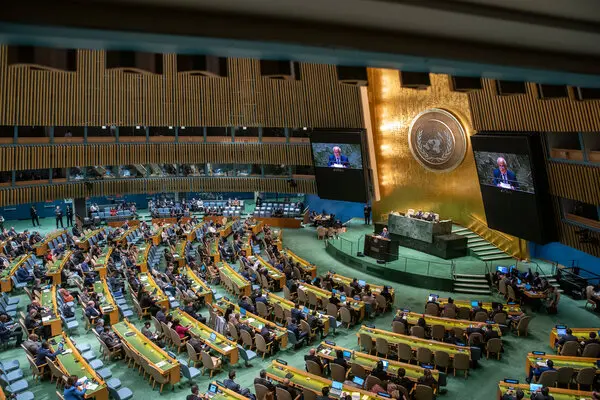The United Nations General Assembly is a platform for world leaders to come together and discuss pressing global issues.
On Thursday, October 26, the General Assembly turned its attention to the ongoing conflict between Israel and Hamas, an issue that has long been a flashpoint in the Middle East.
Here’s what you need to know about this crucial Assembly address.
The Background: The Israel-Hamas conflict is a long-standing and deeply complex issue. It involves historical, political, and territorial disputes that have caused suffering and instability in the region. For years, the UN has been working to find a resolution that will bring lasting peace to both sides.
Key Participants: The General Assembly witnessed the participation of key leaders from both Israel and the Palestinian territories. This included representatives from the Israeli government as well as representatives of the Palestinian Authority, which governs parts of the West Bank. The Hamas leadership, which controls the Gaza Strip, was notably not present at the assembly.
The Debate: The General Assembly debate centred around issues such as the right to self-determination, the status of Jerusalem, the Israeli settlements in the West Bank, and the security and humanitarian situation in Gaza. These are all critical elements of the Israel-Hamas conflict, and the discussions were often impassioned.
International Community’s Role: Numerous countries and international organizations voiced their positions on the matter. Some nations called for a two-state solution, recognizing both Israel and Palestine as independent states living side by side in peace. Others advocated for greater humanitarian aid to Gaza and the West Bank.
The Role of the UN: The United Nations plays a pivotal role in facilitating dialogue and negotiations between the parties involved. Its efforts are aimed at achieving a just and lasting peace in the region. This General Assembly meeting was another step in these ongoing diplomatic efforts.

Civilian Suffering: One of the most poignant aspects of the discussions was the humanitarian situation in Gaza. It has been a source of international concern, with many countries urging Israel to ease restrictions on the movement of goods and people in and out of Gaza to improve living conditions for its residents.
The Ongoing Challenge: Despite various diplomatic efforts over the years, the Israel-Hamas conflict continues. The UN General Assembly’s discussions highlighted the need for a comprehensive and sustainable resolution to bring lasting peace and stability to the region.
Global Implications: The Israel-Hamas conflict is not isolated. Its repercussions extend beyond the Middle East and have implications for regional and global security. The international community continues to be deeply invested in finding a peaceful solution to this ongoing conflict.
What Lies Ahead: While the UN General Assembly serves as an important platform for dialogue and debate, a comprehensive solution to the Israel-Hamas conflict remains elusive. The path to a peaceful resolution is fraught with challenges, and the international community will continue to play a critical role in this process.
In conclusion, the UN General Assembly’s discussion of the Israel-Hamas conflict on Thursday, October 26, was a reminder of the enduring challenges faced by the international community in addressing this complex issue.
It reaffirmed the importance of diplomatic efforts, dialogue, and a commitment to finding a just and lasting solution that ensures peace and stability in the region. The world will be watching as the global community works to make progress on this ongoing issue.






